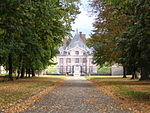Church of St. Peter, Chennevières-sur-Marne
13th-century Roman Catholic church buildings in France13th-century establishments in FranceChurches in Val-de-MarneFrance Roman Catholic church stubsMonuments historiques of Île-de-France ... and 1 more
Île-de-France geography stubs

The Church of St. Peter (French: église Saint-Pierre) is a Roman Catholic church in Chennevières-sur-Marne, Val-de-Marne, France. It is partly listed as a Class Historic Monument.
Excerpt from the Wikipedia article Church of St. Peter, Chennevières-sur-Marne (License: CC BY-SA 3.0, Authors, Images).Church of St. Peter, Chennevières-sur-Marne
Place de l'Église, Créteil
Geographical coordinates (GPS) Address External links Nearby Places Show on map
Geographical coordinates (GPS)
| Latitude | Longitude |
|---|---|
| N 48.795 ° | E 2.5302777777778 ° |
Address
Église Saint-Pierre
Place de l'Église
94430 Créteil, Centre-Ville - Belvédère - Zone d'Activités
Ile-de-France, France
Open on Google Maps









